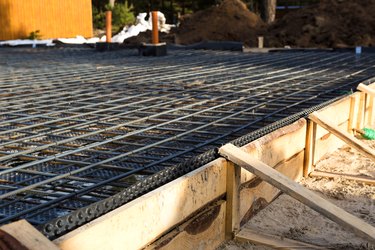
Adding any addition to your home as a DIY project is a big job. Although some house additions that don't require a foundation are possible to build without hiring a professional for some of the work, room additions almost always need the services of a foundation builder.
There are several types of foundations to consider for your room addition. Choosing one will depend on local building codes and how the foundation needs to function in your geographic location. Your foundation contractor is a good source of information to help you decide.
Video of the Day
Video of the Day
Due to the difficulty, complexity, and exacting details of foundation work, building an addition foundation requires hiring a company that specializes in excavating and building house foundations. Here's what to expect during the process.
Calculate the Depth of the Foundation
Regardless of your home's current foundation, your contractor will consult regulation guidelines for your area concerning soil conditions, weather, and other variables to determine how deep your new foundation needs to be. To align with the existing house structure correctly, the contractor will also determine the exact height above grade that the foundation wall needs to reach.
Excavate the Soil
Your contractor will then bring in heavy equipment to remove the soil from the area. They'll need to move enough earth to accommodate the size of the new foundation, any additional footing supports, and plenty of room to work. In rare cases, the soil must be amended before construction can begin by compacting or adding fillers to it, eliminating any risk of the foundation failing under the structure's weight.
Build the Forms
Next, your contractor will build a network of forms to contain wet concrete and hold it in shape until it sets. The forms are most often made as temporary structures using combinations of wood and metal and are firmly anchored to the ground below. Despite some downsides, insulated concrete forms, which are permanent structures that provide a prebuilt concrete form and foundation insulation, are becoming popular and can reduce the need to insulate the basement or crawl space after the construction is complete.
Add the Foundation Materials
Your contractor will then add reinforcing rebar within the forms and pour concrete to fill them. When the concrete has set, rows of cement blocks, or CMUs, are secured to the foundation and built up to the desired height.
Tip
If you’re building your addition as a DIY project, you may consider damp proofing your new foundation with a water-resistant exterior coating after the concrete has cured and before backfilling the excavation.
Backfill the Excavation
After the concrete has cured, your contractor will return with heavy equipment to backfill the site, which is more complex than simply putting dirt back in the hole. As the contractor refills the excavation, they will stop every several inches and compact the soil to ensure against settling later. When the last of the earth is back in the hole, the contractor will grade the area and add a slope away from the new foundation if necessary.